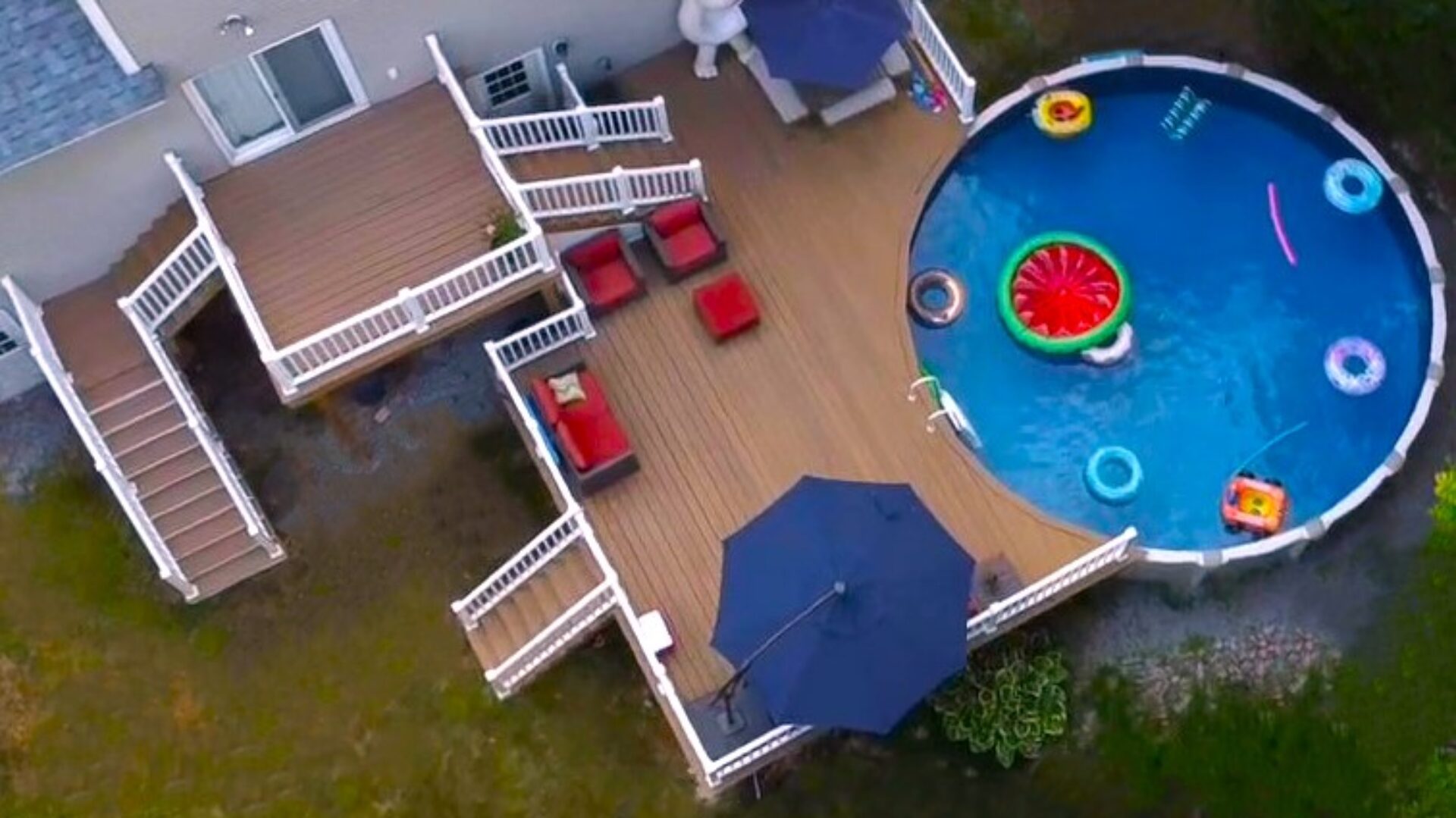If you were standing in Henniker, New Hampshire, two hundred years ago, you’d be hard-pressed to find a deck. Oh, there were porches, certainly—grand wraparound ones on the more distinguished homes, and small, unassuming stoops on the simpler ones. But a deck, as we know it today? That was an idea still waiting to take hold in the American imagination—a future feature of home life that wouldn’t become common until much later in the timeline of deck building history in New Hampshire.
Back then, life in New Hampshire revolved around necessity. The early settlers who first cut their way into these hills weren’t concerned with lounging outside on a Saturday afternoon, sipping lemonade. They were too busy carving farms out of the wilderness, felling trees, and sawing them into planks to build homes that could withstand the cruel New England winters. Lumber was plentiful, but every board was hard-earned, and every nail was precious. The very idea of building an outdoor platform just for leisure would have been downright laughable to a man who spent his days swinging an axe or guiding a team of oxen through the snow.
But as the centuries turned, things changed. The railroad arrived in the early 1800s, and suddenly, wood wasn’t just something you cut in your backyard—it was something that could travel. A board milled in Henniker could end up in Concord, or even as far as Boston. Meanwhile, the lumber industry flourished, sending logs down the Contoocook River, where sawmills transformed them into the raw materials of New England’s homes, barns, and yes—eventually—decks.
White Pine Masts and Their Role in New Hampshire’s History

Long before decks became a fixture in American homes, New Hampshire’s white pine was already making its mark on history. During the colonial era, the tallest and straightest white pines in New England were reserved for the Royal Navy under the infamous Broad Arrow policy, first enacted in 1691. These massive trees, often over 100 feet tall, were cut and sent to England to be used as masts for British ships. The policy, which prohibited colonists from harvesting these prized trees for their own use, became a major source of frustration and rebellion—some even say it helped sow the seeds of the American Revolution, culminating in the Pine Tree Riot of 1772.
Though no longer bound for warships, the same white pines that once defied the Crown continued to shape New Hampshire’s economy well into the 19th and 20th centuries. These mighty trees were felled, milled, and turned into the very planks that made their way into homes, barns, and eventually, decks—a transformation that would become especially relevant starting in the mid-20th century, when outdoor living spaces gained popularity and the concept of the backyard deck truly took root in American culture.
The Lumber Trade and the Sawmills of Henniker
The journey of these logs began deep in the forests of northern New Hampshire and Vermont, where vast stretches of white pine and spruce stood tall. Logging camps, often nothing more than a collection of rough-hewn cabins, housed teams of lumberjacks who felled the trees and dragged them to the riverbanks. During the spring thaw, when the rivers ran high and fast, the logs were rolled into the water, beginning their perilous journey south. The Contoocook River, with its swift current, carried countless logs through towns like Hillsborough and Hopkinton before reaching the sawmills of Henniker. Here, the water-powered mills roared to life, cutting the timber into planks that would find their way into homes and businesses throughout the region.

Historical records from the 19th century note that Henniker had multiple mills operating along the Contoocook, taking advantage of the river’s strong current. These mills were vital to the region’s economy, employing many of the town’s residents and contributing to a vibrant local trade in lumber. The rhythmic hum of saw blades cutting through thick pine logs became the soundtrack of Henniker’s industrious spirit.
It was through these very mills that the legendary loggers of New Hampshire found their work reaching far beyond the forests they knew so well. James E. Henry, a timber baron with an eye for efficiency, understood that getting logs from the deep woods to the mills was only the beginning. He built logging railroads in the late 1800s that made it possible to move cut timber swiftly to towns like Henniker, ensuring that sawmills could process more lumber than ever before. His efforts revolutionized the industry, making wood more widely available for construction, including the decks that would one day become household staples.

William Robinson Brown, a forward-thinking industrialist, also had a hand in shaping the region’s lumber trade. While Henry was focused on speed and efficiency, Brown championed sustainability, ensuring that forests were managed properly so they could continue providing timber for generations. His influence led to improved forestry practices, which in turn helped maintain a steady supply of quality wood for builders and craftsmen across the state.
And then there was Albert “Jigger” Johnson, a man who knew the rivers, the mills, and the lumber trade like the back of his hand. He was a living legend, a true woodsman who could outwork any man in the forest and tell a tale worth listening to while he did it. He and men like him ensured that the mills of Henniker had the raw materials they needed to thrive, keeping the town’s saws humming and its economy strong.

Historic Porches and Decks of the Region
Perhaps the grandest and most iconic porch in the state belongs to the Wentworth by the Sea Hotel in New Castle. Built in 1874, this Victorian-era hotel features a stunning wraparound porch that has welcomed guests—including diplomats and presidents—for over a century. The hotel played host to key negotiations during the 1905 Portsmouth Peace Conference, and its sweeping views of the Atlantic make it one of the most beloved porches in New Hampshire. It’s more than architecture—it’s a piece of living history.

Another nearby example is the Horace Greeley Homestead in Amherst, New Hampshire. The historic house, dating back to the early 1800s, features a classic covered porch that reflects the character and charm of its era. Greeley, the famed newspaper editor and presidential candidate, spent his early years in the region, and the homestead remains a tribute to New England’s architectural traditions—including the practical and communal value of a well-built porch.
Closer to home, the Colby Hill Inn in Henniker is a local gem. With its inviting porch and beautifully crafted deck space overlooking rolling fields, it’s a picture of what leisure means in New England: a rocking chair, a cool drink, and a long view of green hills. Some locals say the porch has been there since the early 1800s, welcoming guests for over a century. Whether or not that’s true, you’ll still find folks out there on a warm summer evening, much like their predecessors.
The Rise of Deck Culture
The deck as we know it began to emerge in the mid-20th century when life in America took on a more leisurely pace. After the Second World War, soldiers returned home, and suburban expansion took hold. Homes grew larger, yards became more manicured, and suddenly, people had the time and means to think about outdoor living. Instead of porches built for practicality—keeping boots dry and offering a place to shake the snow off—Americans began building decks purely for pleasure.
When Did Decks Become Popular?
Though porches had long been a staple of American homes, especially in New England, the modern deck didn’t truly thrive until the 1950s and 60s. Suburban sprawl and the postwar building boom brought with them a desire for more outdoor space—and not just to hang laundry or store firewood. Americans were embracing leisure like never before, and the backyard became an extension of the home: a place to gather, grill, and relax.
Television commercials of the era showed smiling families enjoying barbecues on their new backyard decks. Home improvement magazines featured step-by-step guides for the DIY handyman eager to build one of his own. Pressure-treated lumber, which became more affordable and widely available during this time, made it easier for average homeowners to construct sturdy platforms that could withstand the elements.
By the 1970s and 80s, the deck had become a symbol of the good life—suburban comfort, summer evenings, and quality time with family and friends. It wasn’t just about having a deck; it was about what that deck represented: success, comfort, and a well-earned break.
The Decks of Today
Today, deck designs vary widely. They range from sprawling multi-level entertainment spaces to simple wooden platforms where a couple of chairs and a cold drink are all you need. And here in Henniker, we build them with the same care and craftsmanship that our ancestors once used to raise their timber-framed homes and sturdy barns.
So the next time you step out onto a well-built deck, take pride in knowing you’re stepping into a story—one deeply rooted in deck building history in New Hampshire. Take a moment to appreciate just how far this simple structure has come. It’s more than just a place to sit—it’s a symbol of progress, a nod to the hardworking hands that shaped New Hampshire, and a reminder that sometimes, the best things in life are built to be enjoyed.
References
- Brown, William Robinson. Our Forest Heritage. University of New Hampshire Press, 1958.
- Henry, James E. The Timber Baron’s Legacy. White Mountain Historical Society, 1974.
- Johnson, Albert “Jigger”. Logging Tales of New England. Yankee Books, 1983.
- New Hampshire Historical Society. “The Pine Tree Riot.” Accessed March 2025.
- State of New Hampshire Archives. “Lumber Mills of Henniker, 1760–1900.”
- Colby Hill Inn. “Our History.” https://www.colbyhillinn.com
- Amherst Historical Society. “Horace Greeley Homestead.” https://www.amhersthistory.org
- Wentworth by the Sea. “History.” https://www.wentworth.com
For more on decking materials and Builders, check out our other blog pages on Best Decking Materials For New Hampshire and Deck Builders, How Do I Know I Chose The Right One.
Written by Justin at Kilted Builders, LLC®, deck builders in New Hampshire since 2015. Built on family values and proud craftsmanship, we believe a well-made deck should last as long as the memories made on it.


One thought on “The History of Decks and the Lumber That Built Them: A Look at Deck Building History in New Hampshire”
Very good